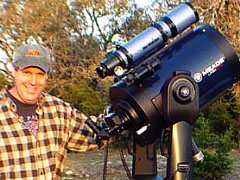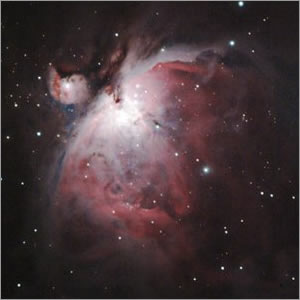 One of my favorite astronomy publications is not a magazine, it is a catalog that Orion Telescopes sends me every month or so. Orion sells a wide assortment of telescopes and accessories and continues to enlarge its offerings with higher-end products. Their prices are quite reasonable, partly due to foreign manufacturing. Historically, a number of companies, including Orion have sold refractors made by Synta Technology Corporation, a manufacturer based in Taiwan. My 80mm ED apochromatic refractor is a Synta product sold under the Skywatcher brand. It is identical to the model that Orion sells, so the accessories that Orion sells for it fit just fine. It is a sweet scope. While many owners of this model have complained of collimation problems, mine is spot on and required none of the DIY customizations that are well-documented on the internet. The optics are very good and I use it almost exclusively for astrophotography.
One of my favorite astronomy publications is not a magazine, it is a catalog that Orion Telescopes sends me every month or so. Orion sells a wide assortment of telescopes and accessories and continues to enlarge its offerings with higher-end products. Their prices are quite reasonable, partly due to foreign manufacturing. Historically, a number of companies, including Orion have sold refractors made by Synta Technology Corporation, a manufacturer based in Taiwan. My 80mm ED apochromatic refractor is a Synta product sold under the Skywatcher brand. It is identical to the model that Orion sells, so the accessories that Orion sells for it fit just fine. It is a sweet scope. While many owners of this model have complained of collimation problems, mine is spot on and required none of the DIY customizations that are well-documented on the internet. The optics are very good and I use it almost exclusively for astrophotography.
Synta, by the way, has just purchased Celestron—another supplier of nice and reasonably priced astronomy equipment.
Meade instruments is a major manufacturer of telescopes. My first real telescope (outside of the Jason spotting scope I received as Christmas present as a kid) was a Meade 4.5″ goto reflector. It is basically a good scope, though I’ve had problems with the cheaply constructed mount and the collimation due to the flimsy construction of the tube. It set me back almost $300 at this time, but gave me plenty of excitement when I could see the rings of Saturn, the Trapezium stars of the Orion Nebula, and the whole gamut of Messier objects. I was blown away at the scopes ability to slew (move) to various objects automatically, which greatly improved my knowledge of the night sky.
With my first case of “aperture fever” I scored an 8″ Orion dobsonian on eBay on the cheap. The day it arrived I sat it up for first light in the driveway and waited for Jupiter to appear in the evening sky. “Setting up” the scope is almost a misnomer, since the scope only comes in two pieces: the tube and the mount. You put the mount on the ground and sit the tube on it so that you can manually push it around up-and-down and sideways. The previous owner stored the scope in his garage pointing straight up—with no dust cover in place. Even though the primary mirror had a coat of dust as a result, first light revealed a spectacular view of Jupiter replete with sparkling clear cloud bands and Galilean moons.
My longing for ever-larger telescopes culminated when I invested in a 12″ Meade LX90GPS. It was my dream scope. With the built in GPS receiver, it was a breeze to set up. Just turn it on and it finds itself (something I’ve been trying to do since adolescence). Having been diagnosed with cancer—and with a heightened sense of mortality—I decided to “seize the day” and go for it. The LX90 was a large “light bucket” that brought to life numerous heavenly vistas. It was too heavy for me to unpack by myself, until months after my successful surgery. Some friends helped me set it up in the living room so I could at least play with the hand controller and test it out. To my profound disappointment, the scope slewed in its Dec axis for about two seconds and then stopped. I could hear the servo spinning, but nothing was moving. My own investigation revealed the that Dec gear box cover screws had not been installed. It had come apart, spilling gears inside the case. Back to the dealer it went and a new replacement arrived about a month later.
My purchase included a CCD camera and laptop; all in a naive attempt to jump head first into the realm of astrophotography. The bigger the scope, the better the images, I reasoned. I had my sights set on the Andromeda galaxy. To my amazement, however, I could not fit the entire galaxy in the field of view. That’s when I learned that many of the best photographic targets in the sky do not really require a great deal of magnification—just long exposures, precise tracking and good optics. As it turned out, the 12″ LX90 did not provide good enough tracking to enable long exposures. For my money, I could have gotten much more suitable equipment. I now use a modified DSLR for imaging (less expensive and much more capable than the Meade CCD camera I purchased), a German equatorial mount (Losmandy G11 in my case) and my trusty Synta/Skywatcher/Orion 80mm ED APO.
For its photographic limitations, the LX90 was fantastic at the eyepiece! Marlena and I joined the 2006 Grand Canyon Star Party and shipped the huge scope ahead of time for our trip. Throughout the star party I had my scope aimed at Saturn to the astonishment of park visitors who peered through the eyepiece. The scope didn’t make it back, however. UPS lost it. That’s another story.
With the money I finally received from UPS for my insurance claim—plus more withdrawals from the bank—I upgraded. Meade had just introduced their new models which incorporated Ritchey-Chretien optics into their Schmidt-Cassegrain line of scopes. So, I bought a 10″ LX200R. The LX200 is Meade’s classic scope. I had finally arrived at what I felt was some kind of truly respectable standing among amateurs. The scope lives up to its reputation and offers pin point stars, clear views and decent tracking. I purchased a polar mount wedge and got more serious into astrophotography.
In 2008, Meade settled a nuisance lawsuit to discontinue referring to their scopes as “Ritchey-Chretien” since they only incorporated part of the RC design. They now refer to them as ACF for Advanced Coma Free. To me, Meade seemed to be in a strengthening market position, in spite of the numerous complains that were ubiquitous about their lack of quality control and poor customer service (which I discovered after receiving my faulty scope). Despite all this, the company seemed to have tons of potential. I even bought stock. Big mistake.
Orion Telescopes and Meade Instruments: the Little Engine that Could and the great underachiever. The catalogs from Orion keep arriving, advertising more products all the time. They’ve also been into e-commerce for years. Good stuff, reasonably priced. Meade stock, on the other hand, has plummeted. I doubt that I’ll ever get much of my money back. They finally started selling their products through their website, which is a big departure from their failed business strategy. Meade scopes are now assembled in Mexico. Take your pick: China or Mexico. Either way, you’ll probably get some good equipment. Just do your homework first.
President Obama: how about a bail out for Meade Instruments?!
